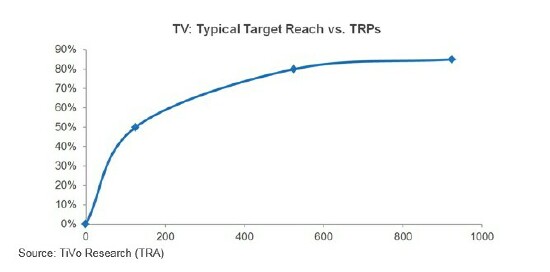What We Have Learned About TV and Digital Advertising -- Part 1

This is the first of a two-part series covering campaign reach, frequency and sales impact. It was written by Bill Harvey and MediaVillage guest contributors Gian Fulgoni and Andrew Lipsman.
An Examination of Reach in TV and Digital
TV has always been known as “the reach medium” -- and with good reason. Within the constraints of a single half-hour time slot, top-rated programs have the ability to reach tens of millions of Americans. Digital, on the other hand, has always been a more fragmented medium with a longer tail of content that typically requires bigger aggregations of media and longer timeframes to deliver against a marketer’s reach objectives.
But as TV becomes more fragmented with viewing habits shifting across time and media platforms, and with digital video audiences growing by leaps and bounds due to the increasing adoption of mobile and over-the-top, we are inching ever closer to convergence. This new media paradigm demands a more unified view of TV and digital, and this begins with a deeper understanding of the essential building blocks of marketing and media planning: Reach, frequency and sales impact. Let’s begin with taking a look at reach.
Delivering Reach on TV
While TV’s status as the reach medium remains undisputed, it is not without its drawbacks. Nowadays, using TV it takes about 125 target rating points and a good optimizer to reach half of your target in a week. Reaching the other half takes a lot more -- the next 400 or so target rating points gets you to about 80% reach. The next 400 after that gets you to only about 85% reach (but this sometimes looks like more in TV panels consisting solely of continuously active research cooperators). The reach curve below illustrates how TV does a very good job at building reach initially, but that the curve quickly flattens out as the marginal reach rapidly declines.

Five years ago, the initial reach build occurred even more rapidly and in five more years the slope of this curve will be even flatter as media fragmentation and time-shifted viewing becoming even more pervasive.
The rapid transition to this environment is testing some of our long-held assumptions about TV reach that demand constant re-evaluation. With a system of GRPs predicated on commercial ratings data, there is a question as to whether these ratings are even accurate reflection of reach. As Ed Papazian, President of Media Dynamics notes: “We have a very high degree of commercial ‘zapping,’ mainly by delayed viewers, which raises the question, are certain people chronic ad avoiders who now use their DVRs to zap ads on almost every show they watch on a delayed basis? If this is so, the implication may be that a new kind of reach curve may be needed that takes into account the source of the GRPs, not only by day part but also by network type or show type, based on zapping rates.”
So how should we be thinking about reach given some of the current complexities? In research conducted with TiVo Research/TRA based upon nationally projected set top box household tuning data, we have found that the best reach strategy -- when buying media exclusively on TV -- has generally been to use an optimal mix including some high rated programs (with brand integration) as well as the long tail, targeted using direct match to purchaser data.
But mounting evidence suggests that while it is possible to optimize within the TV silo, the most effective reach strategies will take a more integrated view of media -- particularly combining TV with digital. In the next article in this series we will cover delivering reach on digital and crossmedia.
Part Two of this report continues here.
Gian Fulgoni is the Co-Founder and Executive Chairman Emeritus of comScore.
Andrew Lipsman is the Vice President, Marketing and Insights at comScore.
The opinions and points of view expressed in this commentary are exclusively the views of the author and do not necessarily represent the views of MediaVillage management or associated bloggers.


